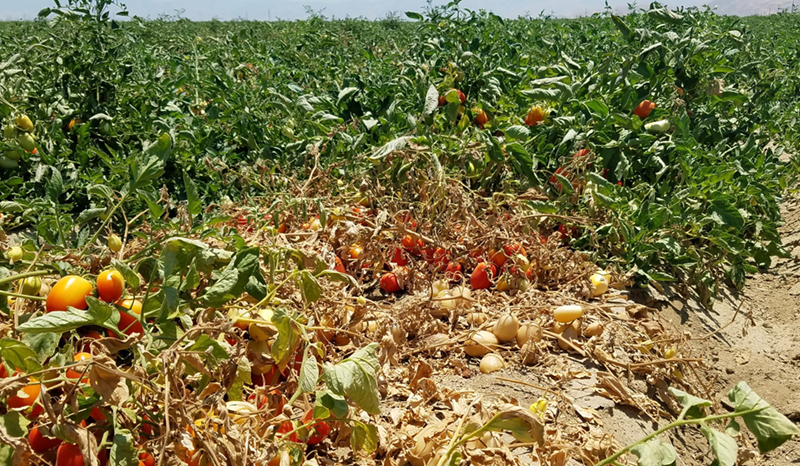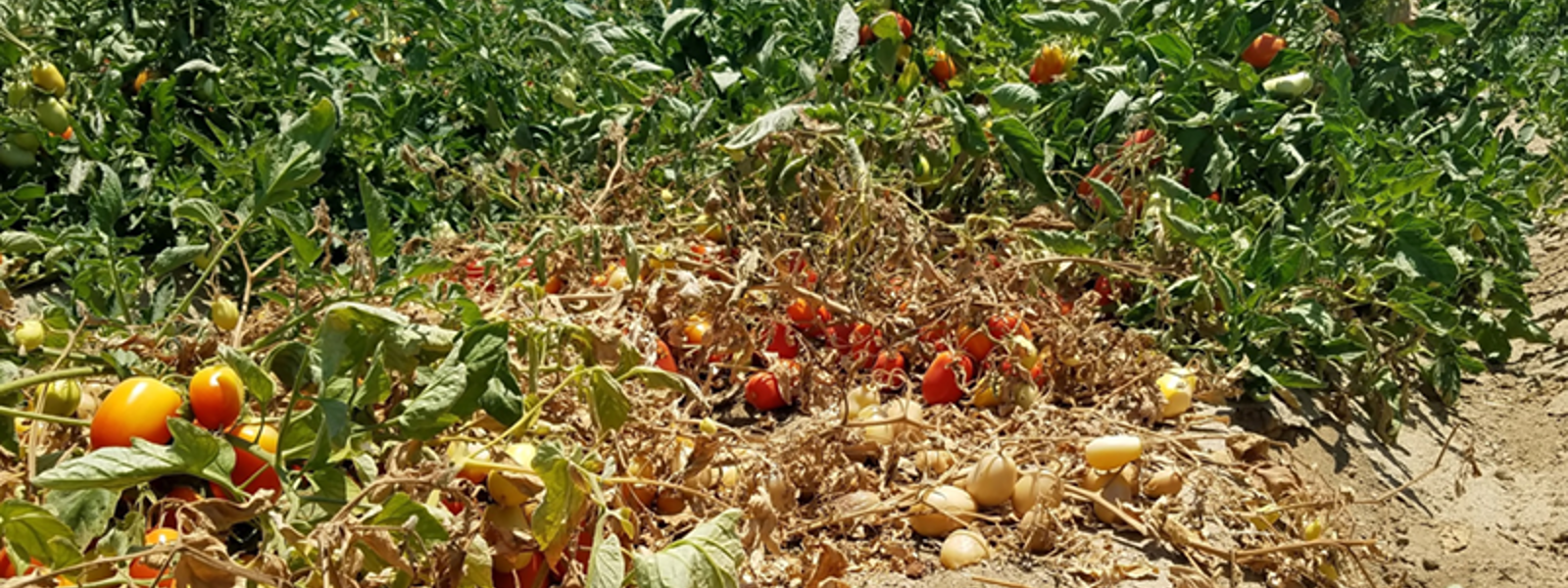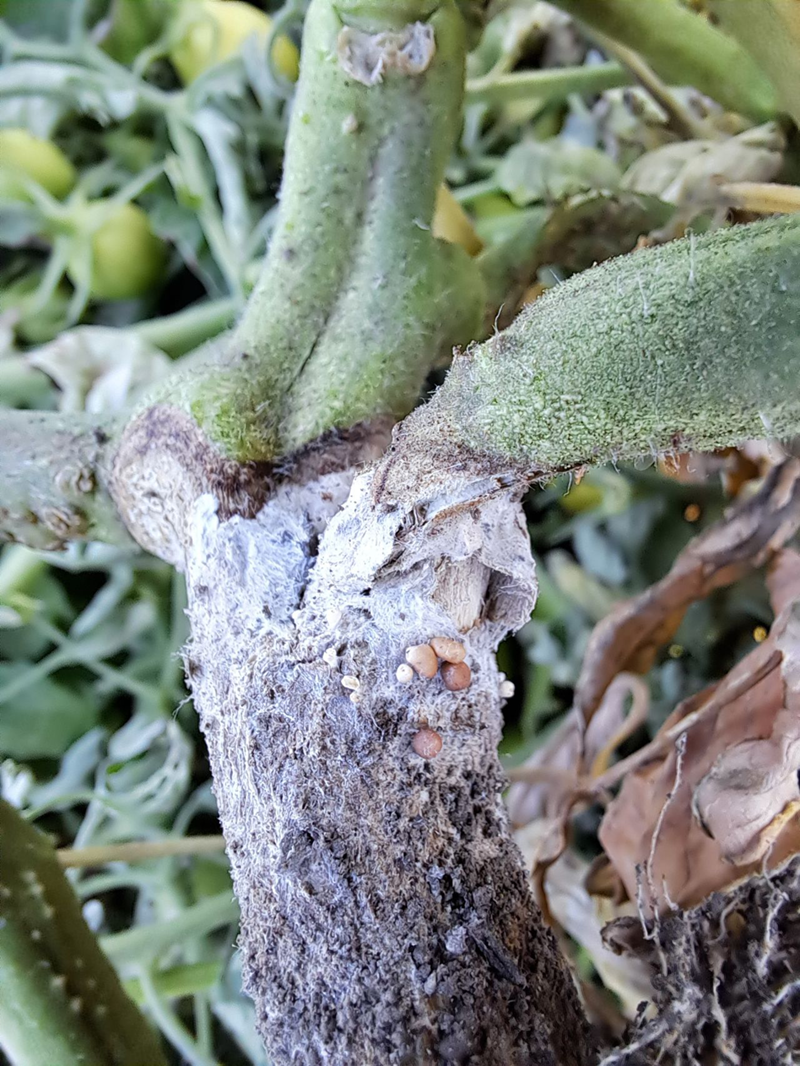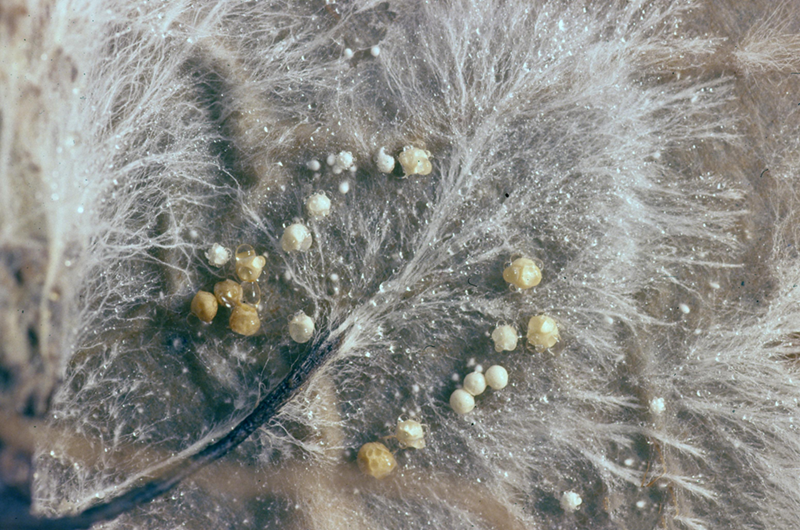Tomato disease spreads to Sacramento Valley fields

The fungal disease southern blight impacts a processing tomato field. Growers have limited options for managing the disease, which can cause tomato plants to permanently wilt, reducing yields.
Photo/Alex Putnam/University of California, Riverside


Photo/Patricia Lazicki, University of California Cooperative Extension

Photo/Gerald Holmes/California Polytechnic University, San Luis Obispo/Bugwood.org
By Vicky Boyd
Spurred by moisture and warm soil temperatures, the fungal disease southern blight is typically a perennial problem of processing tomatoes in the southern San Joaquin Valley. But for the past two years, growers and pest control advisors have seen it in scattered Sacramento Valley fields where it’s been rare historically.
Patricia Lazicki, University of California Cooperative Extension vegetable crops advisor in Yolo and Solano counties, was taken aback by the presence of the crop disease after starting her work in the region in 2023.
“I was actually really surprised because I didn’t think southern blight was a concern we had here,” she said.
This season, she also saw it in scattered tomato and pepper fields, where it tended to be more troublesome at the ends of fields. Lazicki theorized part of the problem may be growers were irrigating more during hot weather to ensure their plants weren’t water stressed.
Even though nearly all processing tomato growers use subsurface or buried drip irrigation, applying too much water can create wet patches on the soil surface. The moist soil, coupled with large plant canopies and hot temperatures, creates a conducive environment for southern blight.
Kurt Richter, who grows processing tomatoes, rice and other row crops in Colusa County, is among those who found southern blight in tomato fields for the first time this season.
“It’s been tough this year,” he said. “Keeping the beds dry has been tough. We’ve run the least amount of water we’ve ever run this year.”
Last season, Richter said he didn’t have a problem keeping the tops of the beds dry, and he did not find southern blight.
Richter wondered if higher flows in the Sacramento River near his fields or the wet spring allowed water to keep seeping into the tops of the beds.
In one field where both southern blight and fusarium have taken down plants, Richter said he expected to see some yield reduction this season. In another field where southern blight is scattered, he said he hoped the disease won’t affect production.
Caused by the soil-borne fungus Sclerotium rolfsii, southern blight begins with small, water-soaked lesions on the lower stem at or near the soil surface. The lesions quickly spread and girdle the stem, reducing water flow from the roots and causing permanent plant wilting. White mats of feathery root-like mycelium also are produced on the stem and in nearby soil.
One of the challenges is managing sclerotia, hard-shelled pinhead-sized bodies that allow the fungus to survive unfavorable environmental conditions. In the case of southern blight, sclerotia may last for several years in the soil. Mycelium also can survive on decaying plant material in the soil, and together they allow inocolum to build in fields.
Jaspreet Sidhu, a UCCE vegetable crops advisor in Kern County, blamed processing tomato plants’ large canopies and the large amount of inoculum in the soil for southern blight being an issue in her area most years.
Tools to help growers and pest control advisors manage the disease are limited. But Sidhu said she is hopeful a fungicide she has in trials will continue to perform well.
“It’s looked promising in initial trials using drip irrigation,” she said. In addition, she has trials to study use of fungicides in potatoes, where overhead sprinklers are used to apply the materials.
Sidhu is conducting the studies under the federal IR-4 project, which supports registration of pesticides for minor or specialty crops. The promising fungicide in her trials is not yet registered for processing tomatoes or potatoes, but the IR-4 project could help expand its label to those crops.
Planting resistant cultivars is one of the preferred lines of defense against many plant pathogens. With a number of other processing tomato diseases, such as tomato spotted wilt virus and fusarium wilt, breeders have developed cultivars with built-in resistance. Sidhu’s predecessor, Joe Nunez, conducted trials for 20 years examining potential southern blight resistance with little luck.
Rotating to a non-host crop usually is part of integrated pest management. But with more than 500 plant species—including processing tomatoes, peppers, potatoes, carrots, onions, garlic and squash —hosting southern blight, rotating to a non-host crop is difficult, Sidhu said. Corn is one of the few reported to not host the fungus.
Lazicki recommended growers practice equipment sanitation when moving machines and tools from one field to the next. Not only does this reduce the potential spread of southern blight, but it also helps manage fusarium fungal diseases and parasitic broomrape.
UC Davis Extension plant pathologist Cassandra Swett has conducted studies to determine the best methods of field sanitation and the time involved. She found blowing off the equipment with compressed air goes a long way to remove dirt clods and plant debris that could potentially harbor pests. And using compressed air was one of the least time intensive.
Another approach by Kern County producers is to plant as early as possible so they can harvest the crop before the really hot summer months.
Because of the relatively cool temperatures in 2023, Sidhu said she saw very little southern blight even in fields where it had been a historical issue. This season was a different story with a few weeks of 107- to 108-degree temperatures and a week of 112 to 116 degrees in early summer. In addition, late winter rains in 2024 delayed tomato planting by 10 days to two weeks, moving some fields into hotter, more conducive weather.
“Most of the time, they’re able to avoid the periods of heat,” she said. “There is always some level of heat in the valley but not to the extent where it’s damaging. This year in Kern was a little bit worse, and some of the fields were having 15% to 20% losses.”
(Vicky Boyd is a reporter in Modesto. She may be contacted at vlboyd@att.net.)




